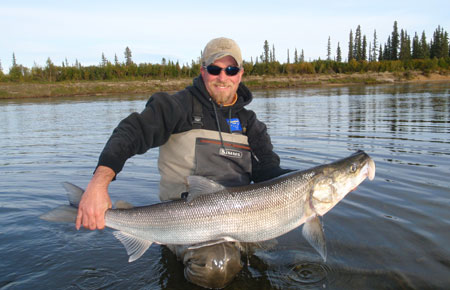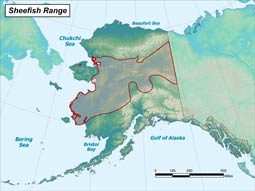Sheefish
(Stenodus leucichthys)
Printer Friendly
Did You Know?
Sheefish travel back and forth from the sea to fresh water looking for food, overwintering areas and spawning sites. They can move over 1,600 kilometers (~1,000 miles) in one year.
General Description
The Sheefish (inconnu) is the largest member of the whitefish subfamily (family Salmonidae; subfamily Coregoninae). Sheefish are white or silvery in color without spots or other markings and have very large scales. The lower jaw extends beyond the upper jaw and the mouth is full of small densely-packed teeth. They can grow to a large size. In the Selawik-Kobuk area of Alaska, sheefish may weigh up to 27 kilograms (~60 lbs) and be over 1 meter (~42 inches) in length. In other areas of Alaska, particularly in interior rivers, they tend to be much smaller.
Life History
Growth and Reproduction
We believe that young sheefish hatch sometime in early spring before the winter ice breaks up. Rapidly flowing spring-melt water carries juvenile sheefish downstream. The young fish end up in backwater eddies along the river, off-channel lakes, and estuary regions at river mouths. All of these areas are good places to find food and hide from predators.
Sheefish grow rapidly. On the Kuskokwim River, sheefish may reach 406 millimeters (16 inches) in length by age 2 and 762 millimeters (30 inches) in length by age 8. Juvenile fish feed mainly on insects and other small prey. As they mature, sheefish will feed almost exclusively on other fish.
The age when sheefish start spawning depends on their location. Sheefish in the Mackenzie River in Canada may reach sexual maturity at age 6. In Alaska streams, males mature at about 6-9 years. Females mature between 7-12 years.
Feeding Ecology
Sheefish captured under the ice near Kotzebue during the winter and spring months have stomachs full of herring. After spring ice breaks up, sheefish spend time in estuaries of the Yukon and Kuskokwim Rivers feeding heavily on oil-rich smelt. Many of these sheefish will then migrate upriver to the mouths of major tributaries and gorge on outmigrating juvenile fish species. How and where a sheefish spends its summer feeding can vary between different populations, within a population, and even in an individual fish. Kuskokwim River drainage sheefish often travel to the same spring/summer feeding areas from year to year whereas others will go to one tributary mouth one summer and a different one the following summer or visit multiple ones over the course of the summer.
Reproduction and Spawning
Sheefish may take up to two months to travel to a spawning area. Sheefish usually return to the same area where they themselves hatched. Similar to other whitefish species, sheefish are “broadcast spawners.” That is, they release eggs and milt into the water column. They do not dig nests. The fertilized eggs drift downstream and sink, becoming lodged in the gravel. Sheefish spawn from late September to early October. Sheefish prefer to spawn in shallow water with temperatures that range from about 0.5° C (33° F) to 5.5° C (42 F). Within a week or two after spawning, sheefish typically leave the area.
Most sheefish spawn only every two or more years. However, some do travel to spawning areas in subsequent years. Due to the high energy requirement of producing between 100,000 to 400,000 eggs, females will usually skip a spawning season.
Migration
Sheefish migrate over long-distances; some over 1,600 kilometers (~1,000 miles) within a single summer. Sheefish in major Alaskan river drainages such as the Kuskokwim, Yukon, Selawik, and Kobuk rivers typically overwinter in the brackish waters of the bays. During spring break up, many sheefish travel upriver to feed. Some will migrate upriver later in the summer to spawn. Some sheefish, called “residents” do not migrate to the bays at all. Instead, they remain in freshwater their entire lives.
Range and Habitat
Sheefish live in large northern rivers and associated lakes of northwestern North America and in drainages of northern Asia to the White Sea. An isolated population occurs in the northern Caspian Sea and its inflowing rivers. They are often found in glacial, silt-laden rivers. Spawning areas can be in clear tributaries as well as those that run silty. Sheefish prefer to spawn over gravel of varying size. This helps insure that the eggs lodge on the bottom and are not carried away by the river current.
Fast Facts
-
Size
Can grow to be 1 meter (~42 inches) in length. Anything over 13.6 kilograms (30 pounds) is considered a trophy sheefish. The record sport-caught sheefish taken from northwestern Alaska was 24 kilograms (53 pounds) -
Lifespan
Can live 20-30 years or more -
Range/Distribution
Northwestern North America and west in the Arctic drainages of northern Asia to the White Sea. Isolated population in the Caspian Sea -
Diet
Juvenile sheefish eat insects. Adults feed almost exclusively on other fish. -
Predators
Adult sheefish and other fish species eat juvenile sheefish. -
Reproduction
Broadcast spawners; can spawn multiple times during their lifespan. -
Remarks
Can be amazing, long-distance travelers. -
Other Names
Commonly referred to as “Inconnu.”
Did You Know?
- Sheefish can live 20-30 years. One sheefish from the Anderson River in NWT, Canada was 39 years old.
- Sheefish travel back and forth from the sea to fresh water looking for food, overwintering areas and spawning sites. They can move over 1,600 kilometers (~1,000 miles) in one year.
- Sheefish may migrate long distances over the course of a year, but will spawn in relatively small and specific locations. For example, in the approximately 775 kilometer-long (724 mile-long) Kuskokwim River drainage sheefish spawn in only four areas; the largest of which is about 24 kilometers (15 miles) long. So far, sheefish have been found to spawn in 6 locations throughout the Alaska portion of the Yukon River.
- Sheefish may take up to two months to arrive at a spawning area, remain for 1-1.5 weeks, and then promptly leave after spawning.
- The Yup’ik and Inupiat of Alaska as well as some Athabascan people call these fish “shees” and thus in Alaska the common name is sheefish. However, in other parts of the circumpolar north, this species is commonly called Inconnu (unknown fish) because early explorers, upon seeing this fish for the first time, did not know what they were.
Uses
Sheefish are a valuable subsistence resource to rural Alaskans. In the Yukon and Kuskokwim rivers, sheefish are usually the first fish seen in the spring after the river ice breaks up. Sheefish are valued as a source of fresh fish prior to the onset of Pacific salmon runs. In other rivers like the Selawik River in western Alaska that do not have salmon runs, sheefish are of even greater importance to the subsistence lifestyle.
Sheefish are a popular sport fish. Sheefish primarily eat other fish, therefore a brightly colored or shiny lure that looks like a small fish in distress will be very enticing to a hungry sheefish. Sport fishing is an important component of the economy in Alaska.
Currently, there is no directed commercial fishery on sheefish in the state of Alaska.
Here is a yummy recipe for halibut that is great with sheefish too.
Management
Fisheries in the State of Alaska are managed for sustained yield. State of Alaska Department of Fish and Game management biologists actively monitor fish stocks and fisheries. They work closely with the public and enforcement officers to ensure compliance with regulations..
Research
Numerous research projects have been conducted on sheefish throughout the state of Alaska. The Alaska Department of Fish and Game, US Fish and Wildlife Service, and University of Alaska have all studied sheefish in recent years. This research has improved understanding of sheefish life history. Many of these projects use radio telemetry (biologists place radio transmitter tags into fish and then follow the signal in order to track the fish‘s movements). The information gathered is used to better manage and protect sheefish stocks and habitat.
Get Involved
- When sport fishing for sheefish, it is best to use proper catch and release techniques (PDF 407 kB) for those you do not plan to keep.
- You can provide input into regulations that affect fishing for sheefish and other species in the state of Alaska by getting involved with your local fish and game advisory committees. Also, public input is welcome in the State of Alaska Board of Fish process.
More Resources
General Information
- Sheefish — Wildlife Notebook Series (PDF 47 kB)
- Sheefish life history and habitat requirements in Alaska (1978) (PDF 643 kB)


